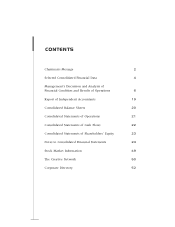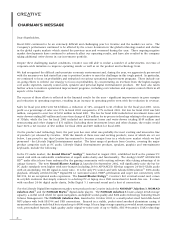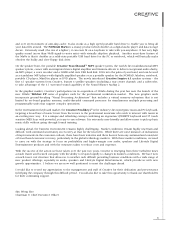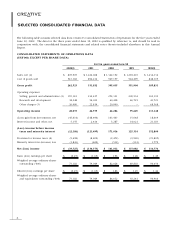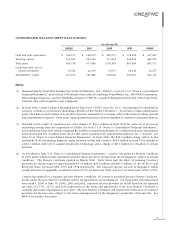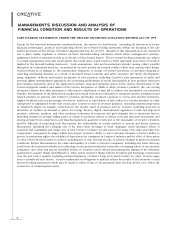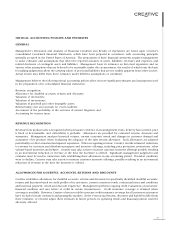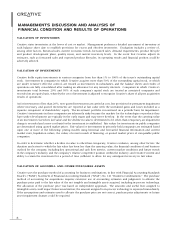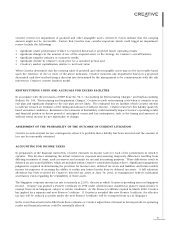Creative 2002 Annual Report Download - page 10
Download and view the complete annual report
Please find page 10 of the 2002 Creative annual report below. You can navigate through the pages in the report by either clicking on the pages listed below, or by using the keyword search tool below to find specific information within the annual report.
8
VALUATION OF INVENTORIES
Creative states inventories at the lower of cost or market. Management performs a detailed assessment of inventory at
each balance sheet date to establish provisions for excess and obsolete inventories. Evaluation includes a review of,
among other factors, historical sales, current economic trends, forecasted sales, demand requirements, product lifecycle
and product development plans, quality issues, and current inventory levels. In the event that Creative adjusts its
estimates, such as forecasted sales and expected product lifecycles, its operating results and financial position could be
adversely affected.
VALUATION OF INVESTMENTS
Creative holds equity investments in various companies from less than 1% to 100% of the issuer’s outstanding capital
stock. Investments in companies in which Creative acquires more than 50% of the outstanding capital stock, or which
are under Creative’s effective control, are treated as investments in subsidiaries, and the balance sheets and results of
operations are fully consolidated after making an allowance for any minority interests. Companies in which Creative’s
investments total between 20% and 50% of such company’s capital stock are treated as associated companies and
recorded on an equity basis, whereby the cost of investment is adjusted to recognise Creative’s share of all post acquisition
results of operations.
As for investments of less than 20%, non-quoted investments are carried at cost, less provisions for permanent impairment
where necessary, and quoted investments are reported at fair value with the unrealised gains and losses included as a
separate component of shareholders’ equity. The investment portfolio is monitored on a periodic basis for impairment.
Creative’s investments in these companies are inherently risky because the markets for the technologies or products they
have under development are typically in the early stages and may never develop. In the event that the carrying value
of an investment exceeds its fair value and the decline in value is determined to be other-than-temporary, an impairment
charge is recorded and a new cost basis for the investment is established. Fair values for investments in public companies
are determined using quoted market prices. Fair values for investments in privately-held companies are estimated based
upon one or more of the following: pricing models using historical and forecasted financial information and current
market rates, liquidation values, the values of recent rounds of financing, or quoted market prices of comparable public
companies.
In order to determine whether a decline in value is other-than-temporary, Creative evaluates, among other factors: the
duration and extent to which the fair value has been less than the carrying value; the financial condition of and business
outlook for the company, including key operational and cash flow metrics, current market conditions and future trends
in the company’s industry, and the company’s relative competitive position within the industry; and Creative’s intent and
ability to retain the investment for a period of time sufficient to allow for any anticipated recovery in fair value.
VALUATION OF GOODWILL AND OTHER INTANGIBLE ASSETS
Creative uses the purchase method of accounting for business combinations, in line with Financial Accounting Standards
Board’s (“FASB”) Statement of Financial Accounting Standard (“SFAS”) No. 141 “Business Combinations.” The purchase
method of accounting for acquisitions requires extensive use of accounting estimates and judgments to allocate the
purchase price paid to the fair value of the net tangible and intangible assets acquired, including in-process technology.
The allocation of the purchase price was based on independent appraisals. The amounts and useful lives assigned to
intangible assets could impact future amortization; the amount assigned to in-process technology is expensed immediately.
If the assumptions and estimates used to allocate the purchase price are not correct, purchase price adjustments or future
asset impairment charges could be required.
MANAGEMENT’S DISCUSSION AND ANALYSIS OF
FINANCIAL CONDITION AND RESULTS OF OPERATIONS



